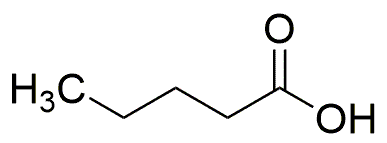Valeric acid is widely utilized in research focused on:
- Flavoring and Fragrance Industry: Valeric acid is used as a flavoring agent in food products and as a fragrance component in perfumes, providing a unique scent profile that enhances consumer appeal.
- Pharmaceutical Applications: It serves as an intermediate in the synthesis of various pharmaceuticals, including anticonvulsants and anti-inflammatory drugs, making it essential for drug development.
- Biochemical Research: Valeric acid is employed in studies related to fatty acid metabolism and energy production, helping researchers understand metabolic pathways and their implications in health.
- Polymer Production: This compound is used in the production of polyesters and other polymers, contributing to the development of biodegradable plastics that are more environmentally friendly.
- Agricultural Chemicals: Valeric acid is utilized in the formulation of herbicides and pesticides, enhancing crop protection and yield while minimizing environmental impact.
General Information
Properties
Safety and Regulations
Applications
Valeric acid is widely utilized in research focused on:
- Flavoring and Fragrance Industry: Valeric acid is used as a flavoring agent in food products and as a fragrance component in perfumes, providing a unique scent profile that enhances consumer appeal.
- Pharmaceutical Applications: It serves as an intermediate in the synthesis of various pharmaceuticals, including anticonvulsants and anti-inflammatory drugs, making it essential for drug development.
- Biochemical Research: Valeric acid is employed in studies related to fatty acid metabolism and energy production, helping researchers understand metabolic pathways and their implications in health.
- Polymer Production: This compound is used in the production of polyesters and other polymers, contributing to the development of biodegradable plastics that are more environmentally friendly.
- Agricultural Chemicals: Valeric acid is utilized in the formulation of herbicides and pesticides, enhancing crop protection and yield while minimizing environmental impact.
Documents
Safety Data Sheets (SDS)
The SDS provides comprehensive safety information on handling, storage, and disposal of the product.
Product Specification (PS)
The PS provides a comprehensive breakdown of the product’s properties, including chemical composition, physical state, purity, and storage requirements. It also details acceptable quality ranges and the product's intended applications.
Certificates of Analysis (COA)
Search for Certificates of Analysis (COA) by entering the products Lot Number. Lot and Batch Numbers can be found on a product’s label following the words ‘Lot’ or ‘Batch’.
*Catalog Number
*Lot Number
Certificates Of Origin (COO)
This COO confirms the country where the product was manufactured, and also details the materials and components used in it and whether it is derived from natural, synthetic, or other specific sources. This certificate may be required for customs, trade, and regulatory compliance.
*Catalog Number
*Lot Number
Safety Data Sheets (SDS)
The SDS provides comprehensive safety information on handling, storage, and disposal of the product.
DownloadProduct Specification (PS)
The PS provides a comprehensive breakdown of the product’s properties, including chemical composition, physical state, purity, and storage requirements. It also details acceptable quality ranges and the product's intended applications.
DownloadCertificates of Analysis (COA)
Search for Certificates of Analysis (COA) by entering the products Lot Number. Lot and Batch Numbers can be found on a product’s label following the words ‘Lot’ or ‘Batch’.
*Catalog Number
*Lot Number
Certificates Of Origin (COO)
This COO confirms the country where the product was manufactured, and also details the materials and components used in it and whether it is derived from natural, synthetic, or other specific sources. This certificate may be required for customs, trade, and regulatory compliance.

